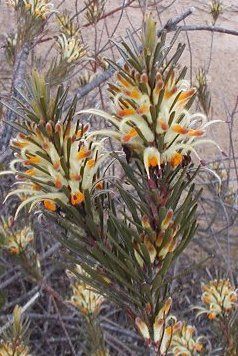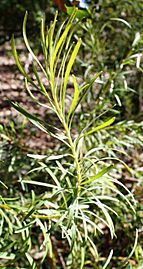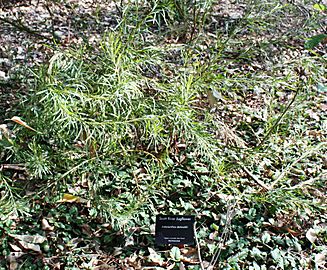Scott River jugflower facts for kids
Quick facts for kids Scott River jugflower |
|
|---|---|
 |
|
| Conservation status | |
| Scientific classification | |
| Genus: |
Adenanthos
|
| Species: |
detmoldii
|
Adenanthos detmoldii, also called the Scott River jugflower or yellow jugflower, is a type of shrub. It belongs to the Proteaceae plant family. This plant grows naturally only in the south-west part of Western Australia.
Contents
What it Looks Like
The Scott River jugflower is a tall, upright shrub. It can grow up to 4 meters (about 13 feet) high. Its branches are covered in fine hairs. The leaves are long and narrow, growing up to 80 millimeters (about 3 inches) long and 5 millimeters wide.
Its flowers bloom between August and November. Each flower has a tube-shaped part called a perianth, which is about 25 millimeters long. A longer part, called a style, sticks out about 40 millimeters. The perianth is bright yellow with an orange center. After the flower is pollinated, this part turns brown.
How it Was Named
Discovering the Plant
The first sample of A. detmoldii was collected around 1870. It was found near the Blackwood River in Western Australia. This sample was sent to a famous botanist named Ferdinand von Mueller. He officially described and named the species in 1874.
Mueller named the plant detmoldii to honor his friend, William Detmold.
Plant Family Tree
A. detmoldii is part of a group of plants called Adenanthos sect. Eurylaema. This group includes other plants with curved, swollen flower tubes.
Sometimes, the Scott River jugflower mixes with another plant called the Adenanthos obovatus. When they do, they create a new hybrid plant known as Adenanthos × pamela.
Where it Grows
The Scott River jugflower is found only near the Scott and Blackwood Rivers. These rivers are located east of Augusta, Western Australia.
Unlike many other Adenanthos plants, this species likes wet, sandy areas. It often grows in places that get very damp in winter. You can find it alongside other plants like Banksia species, Grevillea species, grasses, and sedges. It is often the most common shrub in these wet areas.
Protecting the Plant
The Scott River jugflower is listed as Priority Four - Rare by the Western Australian Department of Environment and Conservation. This means the plant is rare, but it does not seem to be in immediate danger of disappearing.
However, much of its natural home has been cleared for farming. Because of this, many of these plants now grow mostly along road verges.
This plant is also very sensitive to a disease called Phytophthora cinnamomi dieback. This disease can kill the plant.
Growing Your Own
If you want to grow a Scott River jugflower, it prefers light, well-drained soil. It likes full sun or partial shade. Even though it naturally grows in areas with dry summers, it can do well in places with wet or humid summers. However, in humid climates, it might get a fungal disease called grey mould.
You can grow new plants from cuttings taken from semi-mature parts of the plant.
Gallery
See also
 In Spanish: Adenanthos detmoldii para niños
In Spanish: Adenanthos detmoldii para niños





